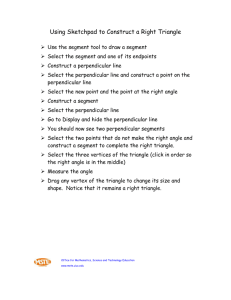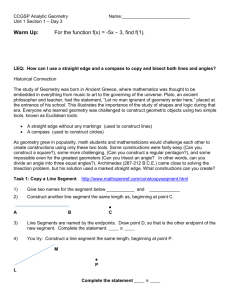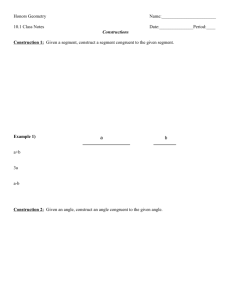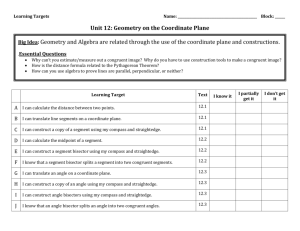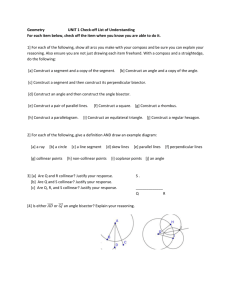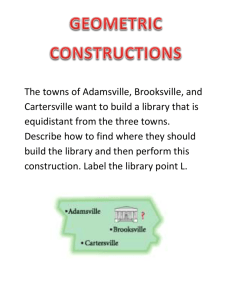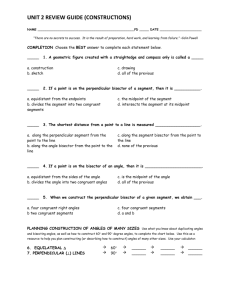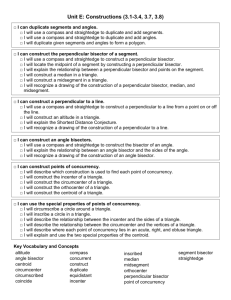16. On a separate sheet, construct an equilateral triangle.
advertisement
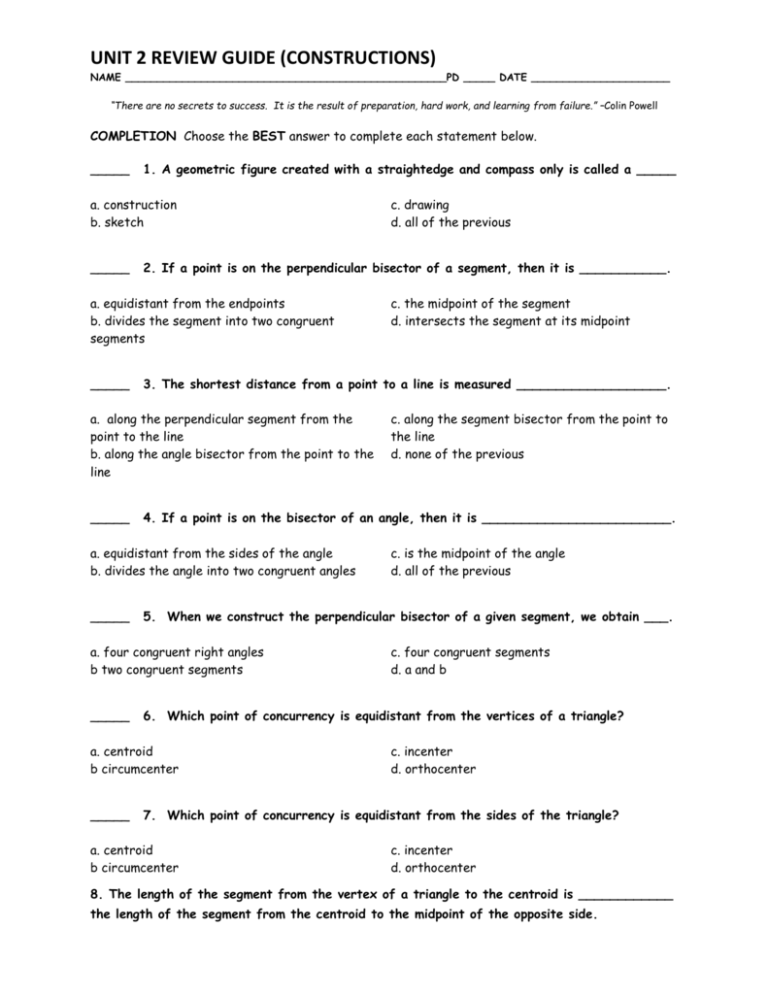
UNIT 2 REVIEW GUIDE (CONSTRUCTIONS) NAME ___________________________________________________PD _____ DATE ______________________ “There are no secrets to success. It is the result of preparation, hard work, and learning from failure.” –Colin Powell COMPLETION Choose the BEST answer to complete each statement below. _____ 1. A geometric figure created with a straightedge and compass only is called a _____ a. construction b. sketch _____ 2. If a point is on the perpendicular bisector of a segment, then it is ___________. a. equidistant from the endpoints b. divides the segment into two congruent segments _____ c. four congruent segments d. a and b 6. Which point of concurrency is equidistant from the vertices of a triangle? a. centroid b circumcenter _____ c. is the midpoint of the angle d. all of the previous 5. When we construct the perpendicular bisector of a given segment, we obtain ___. a. four congruent right angles b two congruent segments _____ c. along the segment bisector from the point to the line d. none of the previous 4. If a point is on the bisector of an angle, then it is ________________________. a. equidistant from the sides of the angle b. divides the angle into two congruent angles _____ c. the midpoint of the segment d. intersects the segment at its midpoint 3. The shortest distance from a point to a line is measured ___________________. a. along the perpendicular segment from the point to the line b. along the angle bisector from the point to the line _____ c. drawing d. all of the previous c. incenter d. orthocenter 7. Which point of concurrency is equidistant from the sides of the triangle? a. centroid b circumcenter c. incenter d. orthocenter 8. The length of the segment from the vertex of a triangle to the centroid is ____________ the length of the segment from the centroid to the midpoint of the opposite side. PLANNING CONSTRUCTION OF ANGLES OF MANY SIZES Use what you know about duplicating angles and bisecting angles, as well as how to construct 60 and 90 degree angles, to complete the chart below. Use this as a resource to help you plan constructing (or describing how to construct) angles of many other sizes. Use your calculator. 9. EQUILATERAL 10. PERPENDICULAR () LINES 60 90 ______ ______ ______ ______ ______ ______ 11. Duplicate, by construction, LUV below. Name your new angle GEO. L U V 12. Duplicate, by construction, the sum of the measures of ’s A, B, and C from the triangle below. Label your new angle as LRG. A construction line and starting point have been provided for you. Remember: Do NOT change your compass setting while swinging arcs on each angle. When you complete your construction, complete the following: The measure of LRG = ________. R 13. Using what is given in a-c below, construct perpendiculars. a. c. Construct a perpendicular, given a point on a line: f b. Construct a perpendicular, given a point NOT on a line: Construct a perpendicular bisector, given a line segment: 14. MATCHING 15. Recall the definitions of each of the following before constructing them in ABC provided below. Construction Tip: It may be helpful to sketch a labeled diagram before actually constructing the figure. ANGLE BISECTOR Sketch: MEDIAN Sketch: Construction: Angle bisector Construction: Median BX ALTITUDE Sketch: BM Construction: Altitude ̅̅̅̅ 𝑪𝑯 16. On a separate sheet, construct an equilateral triangle. 17. On a separate sheet, construct a square. 18. On a separate sheet, construct (using straightedge) a triangle. Then construct the following: (1) incenter, (2) circumcenter, (3) orthocenter, and (4) centroid Which three of these points are collinear? ___________________________________ The line through these three points is called the Euler Line. The Euler Line is named after the Swiss mathematician Leonard Euler (1707-1783) who proved that the three points of concurrency were collinear. Euler’s mathematical output was so tremendous that forty volumes of his writings, representing just a small part of his work, have been published. 19. On a separate sheet, construct an isosceles triangle. (Apply your construction of an equilateral triangle.) Make this triangle have exactly two congruent sides. 20. On a separate sheet construct angles with degree measure as indicated: a. ) 135 b.) 15 21. Describe how to construct, step by step, angles with each of the measures below. HINT: Using a chart (page two of study guide) may help you in putting your plan into words. a. 120 ____________________________________________________________________ __________________________________________________________________________ b. 75 ____________________________________________________________________ __________________________________________________________________________ c. 22 ½ ___________________________________________________________________ _________________________________________________________________________ 22. Point G is the centroid in each diagram below. Find the lengths of the segments listed below using the given information. a) GD=4 BG=6 AG=___ GE = ___ b) AG=22 BE=21 GC=18 AD=___ GE = ___ FG=___ c) AD=12 GE=5 AG=___ BE = ___
